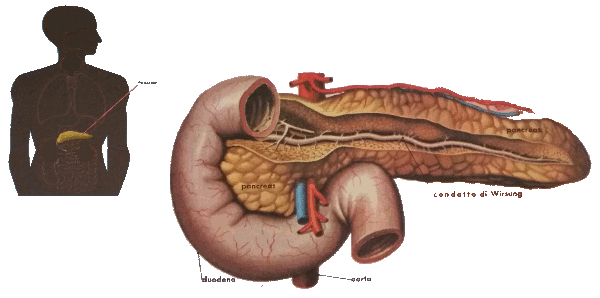SUMMARY
Cryosurgery can also be used on the Pancreas. Fine needle-like probes called cryoprobes are inserted inside the tumor utilizing CT, ultrasound, laparoscopic or direct visual guide. Only careful examination of the patient makes it possible to understand when this technique can be applied. The mimimally invasive percutaneous access is preferred and can be performed using local or general anesthesia. This is an advantage over the other traditional techniques (1) often permitting to remove the tumor without need of opening the abdomen or without the need to manipulate the pancreas as in laparoscopic/robotic techniques. Also for the pancreas cancer the association of immunological therapies and cryosurgery is confirming itself (6) as the new frontier. Our cryoteam in Malaga is at the forefront even in these innovative multimodal advanced therapies.
GENERAL INFORMATION
The pancreas is an organ located between the stomach and the spine. Its role is to produce various hormones such as insulin, and other enzymes such as bile, used by the intestines during digestion.
In literature, the pancreas is divided into three parts: the head, body and tail. Most of the tumors of the pancreas develops from the head, and in particular in the ducts of the bile transport in the intestine. Unfortunately, the cancer cells damage originane very easily metastasize to nearby lymph nodes and organs such as the lungs and liver, and, in 20% of cases, diabetes.
Diagnosis
Unfortunately, pancreatic cancer is asymptomatic until the time when it has become large enough to block several major vessels and bile ducts, at which time it is very likely it has already spread to nearby lymph nodes and organs.
Therapy
Adenocarcinoma of the pancreas is a very aggressive disease that unfortunately is usually discovered too late.
Cryoablation or cryosurgery allows treatment of pancreatic lesions in a minimally invasive and percutaneous, laparoscopic or open. Is indicated when surgical excision is not possible.
Only a careful examination of the patient can understand when this technique can be used. It is preferred to form the percutaneous local or general anesthesia every time that the tumor is attackable by this route. For the benefit of other traditional techniques (1) it allows often can remove the tumor without the need to open the abdomen and no need to manipulate the pancreas as in laparoscopic techniques.
Sometimes it can be given to control the pain often associated with advanced forms of cancer of the pancreas. (2)
The technique is performed without removing the tumor that remains where she was after being necrotic, then the body will reabsorb it in the normal life cycle of the tissues. (3)

